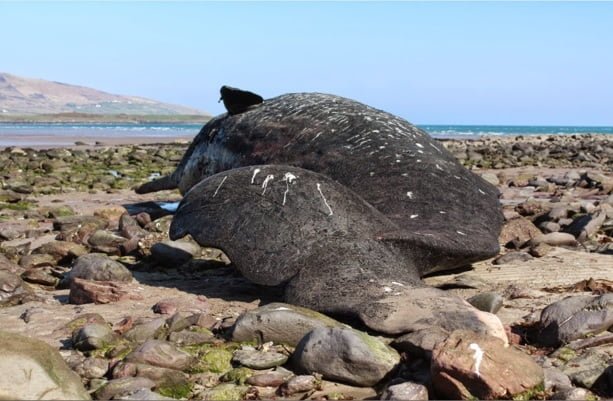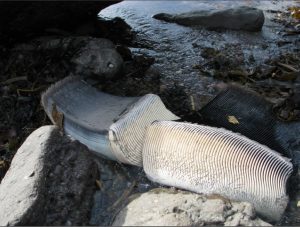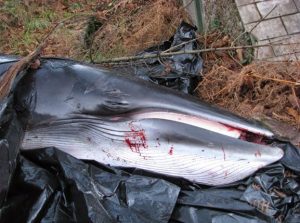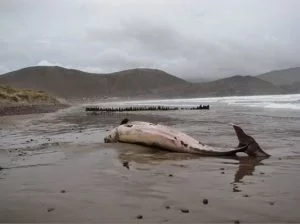In this guest post marine biology student Sean O’Callaghan, a keen cetacean enthusiast and admin of the popular Kerry’s Wild Side page on Facebook, explores some of the benefits of visiting a dead whale.

Visiting a dead whale may appear on the surface to be a morbid proposition, but there are many positives that outweigh the obvious concern; that being a large decaying whale carcass and all that it entails.
Firstly the animal isn’t going anywhere quickly unless the local County Council decides to bury it on site, tow it out to sea or remove it for disposal by other means. Secondly such stranding’s can provide intriguing insights into species which we seldom get the opportunity to study alive in the open Atlantic, in-particular deep diving species like the elusive beaked whales and the planets largest carnivore… the sperm whale.

A number of whale stranding’s occur every year, along with the more common stranding of smaller cetaceans (porpoises and dolphins). While some regions tend to have a higher percentage of larger animal stranding’s, you never know what could wash in.
More often than not the animals wash in on the tide, already dead and at various stages of decomposition. An animal whose remains are feeling the breakdown effects of death may, understandably, be an unattractive proposition, but it provides a fascinating opportunity to learn about these remarkable animals.
Take the first sperm whale stranding I visited back in 2009 on the Magharees in West Kerry. It was a massive bull, and largely intact, but the adjacent rock pools were filled and covered with a waxy, milky substance: spermaceti oil. This once widely used commodity is what inspired the species’ name. I would, of course, jump at the chance to see a living sperm whale surface in the flesh, but I would never have encountered this intriguing oil had the whale been alive (the oil liquefies when warm and solidifies when cooled which is thought to play a role in the deep diving animal reach, and return from, the extraordinary depths of the abyssal plains).
Stay away from live cetacean strandings
Dead cetaceans offer a glimpse into the inner and outer workings of these creatures — and depending on the state of decomposition reveal the bones, and other internal and external anatomical features that can be fascinating. But of course not all whales are dead and decomposing when they wash up. When a whale beaches itself alive (an event called a live stranding) the incident typically receive widespread media coverage, and that tends to draw crowds.
I would not advise you to visit a live stranding. That may seem like strange advice, given the topic of this article, but there are sound reasons for it. First and foremost is the animal’s welfare — very simply, the less people at a stranding, event, the less added anxiety an already stressed animal is going to be exposed to. Secondly, live strandings can be pretty gruesome affairs. They typically occur in relation to compromised animals that come ashore in a distressed state, and the outcome is often inevitable. Unfortunately the words “happily ever after” rarely apply to a cetacean stranding.

Rushing to see a live whale or dolphin up close may seem like a fabulous opportunity, but the reality can be horrific. You’re likely to be confronted by a panicked animal in the final throes of its existence. Live strandings evoke an almost visceral response in people… a feeling that we should do more to save the distressed animal. It’s a reaction usually borne of an overly simplistic view of a complex unfolding scenario.
People in charge on the ground, from various organisations, will be making decisions based on their collective expertise and experience — and the best thing you can do for the animal and your own peace of mind is to keep your distance and let them get on with their jobs.
It is a sad fact that the vast majority of live-stranded cetaceans — even those that are re-floated successfully and coaxed back out to sea, usually die soon afterwards. That is the best time to visit a stranded whale. Before decomposition starts to take hold you can witness the true majesty of these leviathans. Encountering a living whale from a boat is an awe inspiring and humbling experience, certainly, but even if you’re lucky enough to view one at close quarters, you generally only see a relatively small part of the animal at any one time: the head, the back and dorsal fin, perhaps the tail flukes.
While it is always sad to see these magnificent creatures lifeless, it also provides an unmissable opportunity to see the animal in its entirety, and at leisure. You have time to take in the scale: the size of the head, the breadth of the flukes, the rows of baleen plates hanging from the upper jaw, or teeth, depending on the species.
Finding out about local strandings
Many people have been drawn to stranding’s over the millennia to catch sight of these marine megafauna in the flesh. In our ever-connected modern world today learning about nearby stranding events is easier than it’s ever been. Live stranding’s are more likely to be picked up and reported by mainstream media, and can draw large crowds, while the less attractive, well dead strandings are more likely to be picked up by local media, but can still reel in the public on occasion.
Now it’s all well and good heading down to your nearest whale stranding with camera in hand, but how do you know there’s a colossal carcass lying on that particular beach or stretch of coastline in the first place?
Well there are a number of ways to do so.
- Social media: Twitter, Facebook et. al. have fast become a practically real-time information source for unfolding stranding events, and often have accompanying images or video of the animal(s) in question.
- Local media: breaking news on local radio stations, or the slightly delayed reports in local newspapers can often give you information on local stranding events.
- The Irish Whale and Dolphin Groups Strandings Database: I regularly check stranding’s reported via the Irish Whale and Dolphin Group’s online stranding database. It offers the most up-to-date, efficient and expertly verified information on cetacean strandings around the Irish coast.
NB. The IWDG’s online stranding database is also THE place to report stranded cetaceans to the Irish Whale and Dolphin Group so they can collect valuable conservation data — if you find a dead whale, dolphin or porpoise around the Irish coast please report it to the IWDG using this online reporting form.

To find a whale yourself requires two key factors: the weather (crucially the wind) and luck!
Stormy conditions, particularly strong westerly winds, increase the possibility of a stranding greatly, the true giants are out there in the deep Atlantic blue, and such winds may push a carcasses to shore before it sinks to the murky depths. The luck element is fairly self explanatory — but as with most wildlife related subjects, the more you look, the luckier you’re likely to get.
Just before you decide to high-tail it down to your nearest and latest stranding, there are some points to consider:
- Take care by the sea: stormy weather can often accompany and even cause stranding’s do not take unnecessary risks; it’s not worth it. Keep an eye on the tide as well, the last thing you want to do is get caught out.
- Never touch a carcass: this may seem basic, but I have observed people handle whale flesh in various stages of decay, for reasons known only to themselves. Doing so exposes you to unnecessary and potentially major health hazards.
- Respect the animal: I have witnessed first-hand on numerous occasions the kind of disrespect shown to a dead cetacean and it’s truly saddening.
So go on… get outside… tilt your nose in the winds direction and go find yourself a whale. It will be well worth your while!
NB: The opinions, advice and information expressed in individual guest posts are those of the respective author or authors, and do not necessarily reflect the views of Ireland’s Wildlife. If you’d like to share your opinion about this article please use the comment form below.









6 comments
Padraig
All good Sean……hope you’re having a good summer out West.
Padraig Whooley
More importantly than the IWDG website being simply a resource where Necro Twitchers can trawl to find the latest cetacean strandings, but for 25 years it has been the primary and most efficient way for members of the public to report any cetacean stranding records, dead or alive. So please report to IWDG.
Sean O'Callaghan
Quite right Padraig, I was sure I had mentioned to report any strandings to the group in the piece.
Thanks for picking up on it.
Calvin Jones
Absolutely — good point Padraig. We highlight the IWDG sightings scheme in cetacean related articles regularly — and it will feature prominently in a planned feature article on recording schemes and citizen science projects in the not too distant future.
Sean was referencing the site in the context of his article on stranded whales, but the sighting’s database is, of course, the best resource for anyone looking for up to date information on live cetacean sightings around the Irish coast — and is the best way of reporting your whale and dolphin sightings to the IWDG where they will help inform ongoing conservation efforts.
You can query the IWDG sightings database here, and report your sightings using the sighting form here.
When’s the IWDG mobile app for reporting real-time sightings from the cliff top coming out? 😉
Padraig
HI Calvin….i didn’t make any reference to the sightings database on http://www.iwdg.ie, only the strandings. This was to make the point that members of the public should also use it in order to report any cetacean strandings to IWDG, as against merely using it to find what has stranded in the past. Cheers.
Calvin Jones
Ah right… with you now — good point. Will add a link to the stranding reporting form in the body of the article.
Cheers!